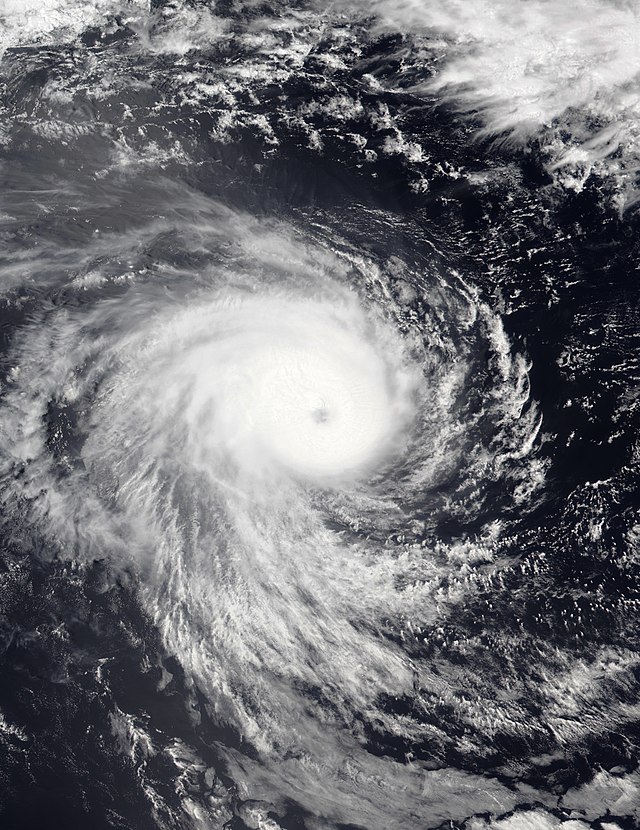Top Qs
Timeline
Chat
Perspective
List of Category 4 Australian region severe tropical cyclones
From Wikipedia, the free encyclopedia
Remove ads
Category 4 is the second-highest classification on the Australian tropical cyclone intensity scale which is used to classify tropical cyclones, that have 10-minute sustained winds of at least wind speeds of 86–107 knots (159–198 km/h; 99–123 mph). As of 2019[update] 47 tropical cyclones have peaked Category 4 severe tropical cyclones in the Australian tropical cyclone basin, which is denoted as a part of the Indian and Pacific Oceans to the south of the equator and between 90°E–160°E. The earliest tropical cyclone to be classified as a Category 4 severe tropical cyclone was Gyan which was classified as a Category 4 during 22 December 1981, as it impacted New Caledonia. The latest was Pola as it passed between Fiji and Tonga. This list does include any tropical cyclones that peaked as a Category 5 severe tropical cyclone, while in the Australian region.

Remove ads
Background
Summarize
Perspective
The Australian region tropical cyclone basin is located to the south of the Equator between 90°E and 160°E.[1] The basin is officially monitored by the Australian Bureau of Meteorology as well as the Indonesian Agency for Meteorology, Climatology and Geophysics (BMKG), and the Papua New Guinea National Weather Service.[1] The United States Joint Typhoon Warning Center (JTWC) and other national meteorological services such as New Zealand's MetService, Météo-France and the Fiji Meteorological Service, also monitor parts of the basin in an unofficial capacity.[1] Within the basin a Category 4 severe tropical cyclone is defined as a tropical cyclone that has 10-minute mean maximum sustained wind speeds of 86–107 knots (159–198 km/h; 99–123 mph) on the Australian tropical cyclone intensity scale.[1][2] A named storm can also be classified as a Category 4 tropical cyclone if it is estimated to have 1-minute mean maximum sustained wind speeds of between 113–136 knots (209–252 km/h; 130–157 mph) on the Saffir-Simpson hurricane wind scale.[1][3] This scale is not officially used by any of the warning centres for the region, but tropical cyclones are compared to it by various agencies, including NASA.[1] On both scales a Category 5 tropical cyclone is expected to cause widespread devastation if it significantly impacts land at or near its peak intensity.[2][3]
Remove ads
Systems
1970s
1980s
1990s
21st Century
Remove ads
Other systems
- Chris–Damia – Cat 4 in SWIO.[76]
- Walter–Gregoara – Cat 4 in SWIO.[77]
- Harriet–Heather – Cat 4 in SWIO.[78]
- Uriah – Cat 4 in SWIO.
Over the years, the intensity estimates of tropical cyclones have been reanalysed for various reasons and were found to have been underestimated by the various warning centres.[79][80] In particular, during a database repair project that took place between 2005 and 2007, the BoM discovered that Severe Tropical Cyclone Pam of 1974, had been reanalysed at some point after 1979.[8] This reanalysis showed that Pam had moved out of the South Pacific region and into the Australian region, as a category 5 severe tropical cyclone.[8] However, a later reanalysis by the BoM during 2021 downgraded it to a category 4 severe tropical cyclone, as it was thought that the width of the southern eyewall was too narrow for a category 5 severe tropical cyclone.[8]
Impacts
This section is empty. You can help by adding to it. (December 2019) |
Records and statistics
This section is empty. You can help by adding to it. (December 2019) |
See also
References
External links
Wikiwand - on
Seamless Wikipedia browsing. On steroids.
Remove ads
